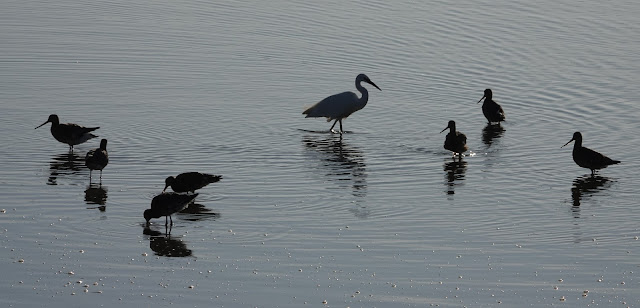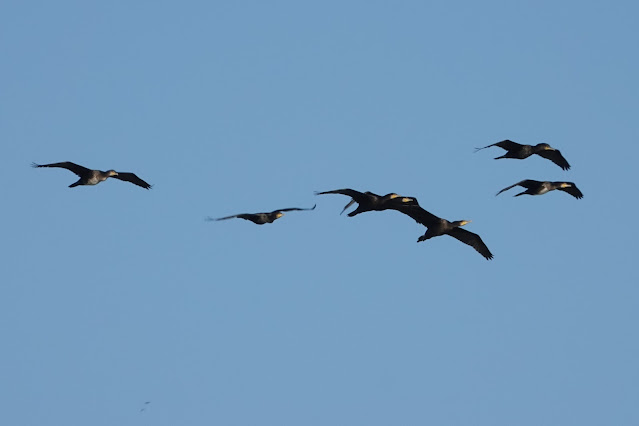It was an early start to be at Heybridge Basin at 730 but
with the forecast set to be another scorcher it felt like best idea. It was already very warm but still and calm
with the smell of the salty Blackwater and chaff from the surrounding harvest in
the air. It was a quintessentially summer aroma.
A Goldcrest or two greeted us in the car park as we sorted
ourselves out but remained secreted in the Cypress while a Swallow alerted us to
a female Sparrowhawk zipping through.
I had judged the amount of time before high tide well –
about two hours – but had not known that the mud actually disappears
appreciably before that time which meant that most of the Black-tailed Godwits
were already on Heybridge GP. There was
a good scattering along the dwindling tideline with a couple of Oystercatchers
and six Ringed Plover but there were no little waders to check through at all
and it took ages to find Redshank, Lapwing and even a Curlew.
Two Common Sandpipers flicked down the canal and another was
on the pit margin along with four Greenshank.
 |
| Cormorants |
A Buzzard would have probably snuck through without
disturbing the Godwits but a Lesser Black-backed Gull took umbrage and a
swirling mass of waders took to the air and headed further up towards Maldon.
 |
| Buzzard and friend |
 |
| Black-tailed Godwits |
Common Terns moved back and forth between river and pit and
young big gulls persistently followed their respective parents whining for a meal.
 |
| A fine Barge display at Maldon Prom |
 |
| Common Tern |
A few Warblers were moving through the bushes with single
Willow Warbler and Chiffchaff and several of each Whitethroat, Reed and Sedge
Warbler while buff headed Goldfinches attacked the Creeping Thistles. Rather oddly there was not a single Dragonfly
of any sort seen and just four Butterflies – a Small White and three Wall
Browns.
 |
| Wall Brown |
A Red Kite circled distantly over the town and a few Tufted
Ducks and Pochard loafed around the pits but it was getting a little toasty so
we ambled back to the cars passing some dust bathing Sparrows and a couple of stately outgoing Barges on the way.
 |
| House Sparrows |
On to Abberton and the Leyer Breton Causeway where there was
not a breath of wind – a most odd scenario.
It was, as I had hoped, white bird central with seven Great White Egrets
around the closest edges and the dots of more distant ones, a fine adult
Spoonbill feeding in the enclosed corner before heading off out of sight to the
opposite one and ignoring its begging youngster on the island. The flock of ten or so others was absent or
out of view. The juvenile only fledged on
Sunday and was the first proper Teaspoonbill I have ever seen.
 |
| Great White Egrets |
 |
| Great White Egret |
 |
| Spoonbill |
 |
| Spoonbill |
 |
| Teaspoonbill |
 |
| Teaspoonbill |
The Egretry was still in full swing with some late Little Egrets
nest but also several (five?) Cattle Egret nests on which prehistoric infants
stood panting. Adults were coming and
going and I reckon we saw about eight or so.
It is amazing how quickly fortunes change and I remember dashing up here
twenty years ago for the first twitchable Essex Great White found by Adrian
Kettle. I wonder if they will break the
fifty mark during September?
 |
| Egrets |
 |
| Cattle Egret |
 |
| Juvenile Common Tern |
The causeways were littered with moulting Canada and Greylag
Geese with numerous Egyptian and a single Barnacle Goose amongst them while 18
Black-tailed Godwits, three Green, two Common and a spangled Wood Sandpiper fed
around the sandy islands.
The heat and the need for the loos sent us around to the
visitors centre where an early lunch was also taken while watching a raft of
several hundred Cormorants collectively feeding in the bay while another Great
White was noted heading over to Wigborough.
Linnets and Goldfinches were in the Thistles and a flock of Pied
Wagtails ensured that a female Sparrowhawk did not even get the chance to hunt.
I did not fancy any more time in the open at the reservoir so
we trundled east to Fingringhoe Wick where at least we could nip in and out of
the shade. A Red Kite greeted us upon arrival before the walk down to Margaret’s
Hide added Green Woodpeckers and a few Dragonflies at last with Brown and Migrant
Hawkers and both Darters but my highlight was in a reedy channel that crossed
the path where stood the most magnificent display of Marsh Sow Thistles. Not only were they the first I had seen ‘in
the wild’ but they were actually my plants that I grew from seed best part of
ten years ago.
 |
| Ruddy Darter |
 |
| Marsh Sow Thistles poking through the Phragmites |
 |
| Marsh Sow Thistles |
The short story – I was given two parent plants by a chap
who was part of an official re-introduction programme of this now very
restricted species, with a view to us putting them at Rainham Marshes where
they must have once lined the ditches but because there was no official record of
them we were not allowed to plant them out.
I grew them on and collected the seed and found them very easy to grow
on. When they were about two years old I
got approached with a view to planting them out at Fingringhoe and thus about
forty plants headed off to be used as part of the rewilding and breaching
project at the reserve but as with most of these things I never heard any more.
 |
| Marsh Sow Thistles |
Fast forward to yesterday
and there they were in all their mature glory with some clumps as big as
dustbin lids and the tallest flowering stems beating the 11 foot reached by my
own last year by several feet! Many were already going to seed so let’s hope
they manage to spread out once again along the waterways of the county.
 |
| Must have been 15 foot tall! |
I was somewhat taken aback at the scale of the breach
lagoon. This managed retreat was immense
but as the tide had already largely dropped it was a muddy moonscape for the
most part but we gratefully escaped the sun in the creaky hide and actually
collected a good little spread of waders with several hundred Black-tailed
Godwits, six Curlew, six Avocet, two Dunlin, two Golden Plover, two Grey
Plover, eight Lapwing, six Oystercatcher, seven Greenshank, ten Redshank and singles
of Bar-tailed Godwit and Turnstone. A single Shelduck was making trails in the
mud and young Black-headed Gulls followed their parents and thankfully there
was not a single dead bird to be seen.
 |
| Curlew |
Small Coppers dotted the path on the walk back and we found a
poorly Oak with many sap runs with Hornets, Wasps, Greenbottles and a Red Admirals
in attendance. Hornets are stunning
beasts if they are distracted and you can get in closer for a look!
 |
| Hornets |
 |
| Hornets |
 |
| Red Admiral |
It was now mid-afternoon and almost uncomfortably hot so we
retreated for an icecream with the added bonus of a Willow Emerald, a plump Araneus quadratus and a couple
of elusive calling Bullfinches.
 |
| Araneus quadratus |
 |
| Willow Emerald |
Retracing out steps we had a quick look at the Layer de la Haye causeway at Abberton where two juvenile Little Ringed Plovers became our
17th species of wader for the day and young Yellow Wagtails flew
around calling with the numerous Pieds. The dead fallen tree in the closest
corner was littered with Egret decorations with at least seven Great Whites
amongst the Littles in and around it. A
final look from Billets Farm added no waders, just zillions of Coots, Mute
Swans and brown eclipse ducks but there were more Yellow Wagtails, a few of all three hirundines and a pair of
silent Skylarks to round up proceedings.
It was good to get in the car and on my way with all the windows open after
a somewhat sweaty but successful day.
 |
| Who would have ever thought that this would be normal at Abberton? |












































A great day out with great company - thanks Howard - I stopped a little longer and upped the wader count to 18 with a Ruff.
ReplyDeleteReally enjoyed reading that on my way home on the train. Great pictures too.
ReplyDelete